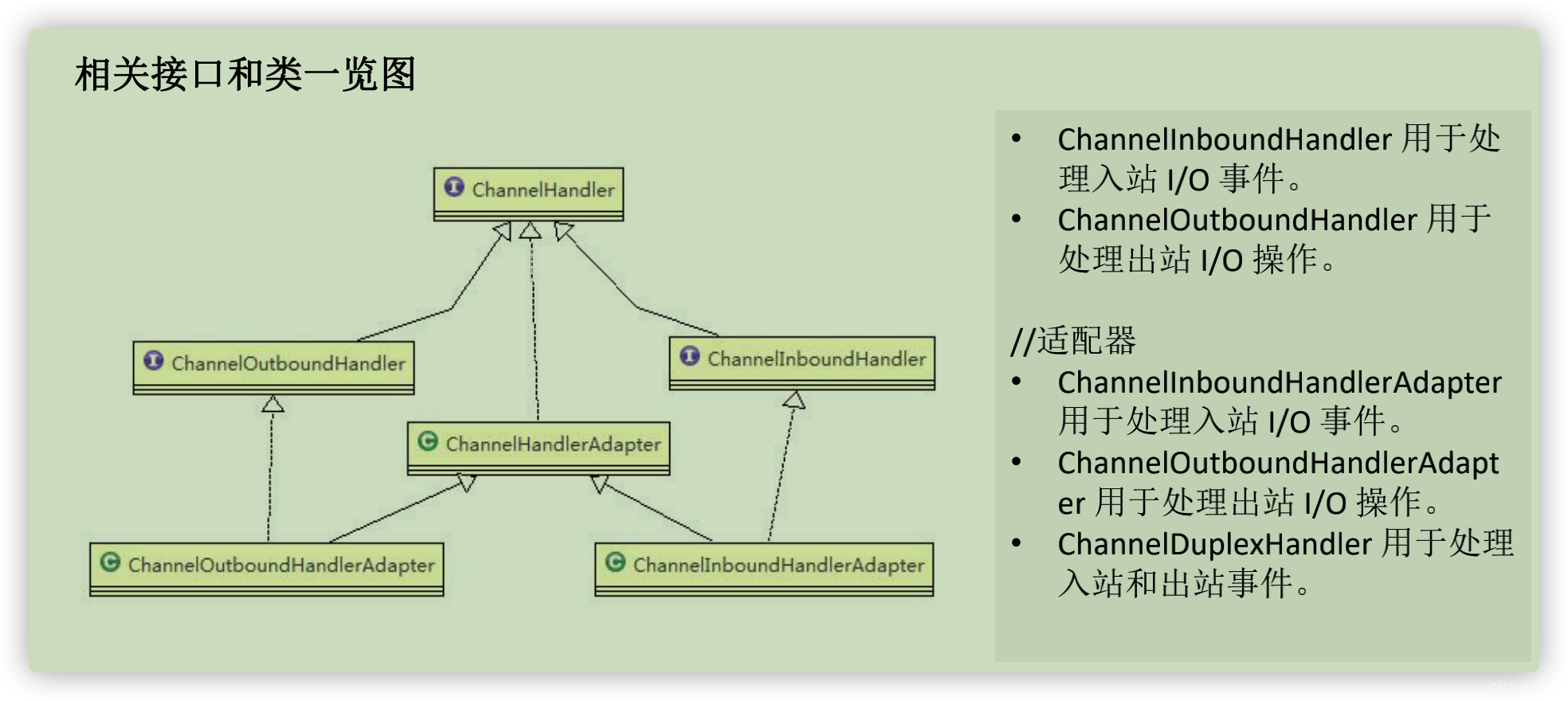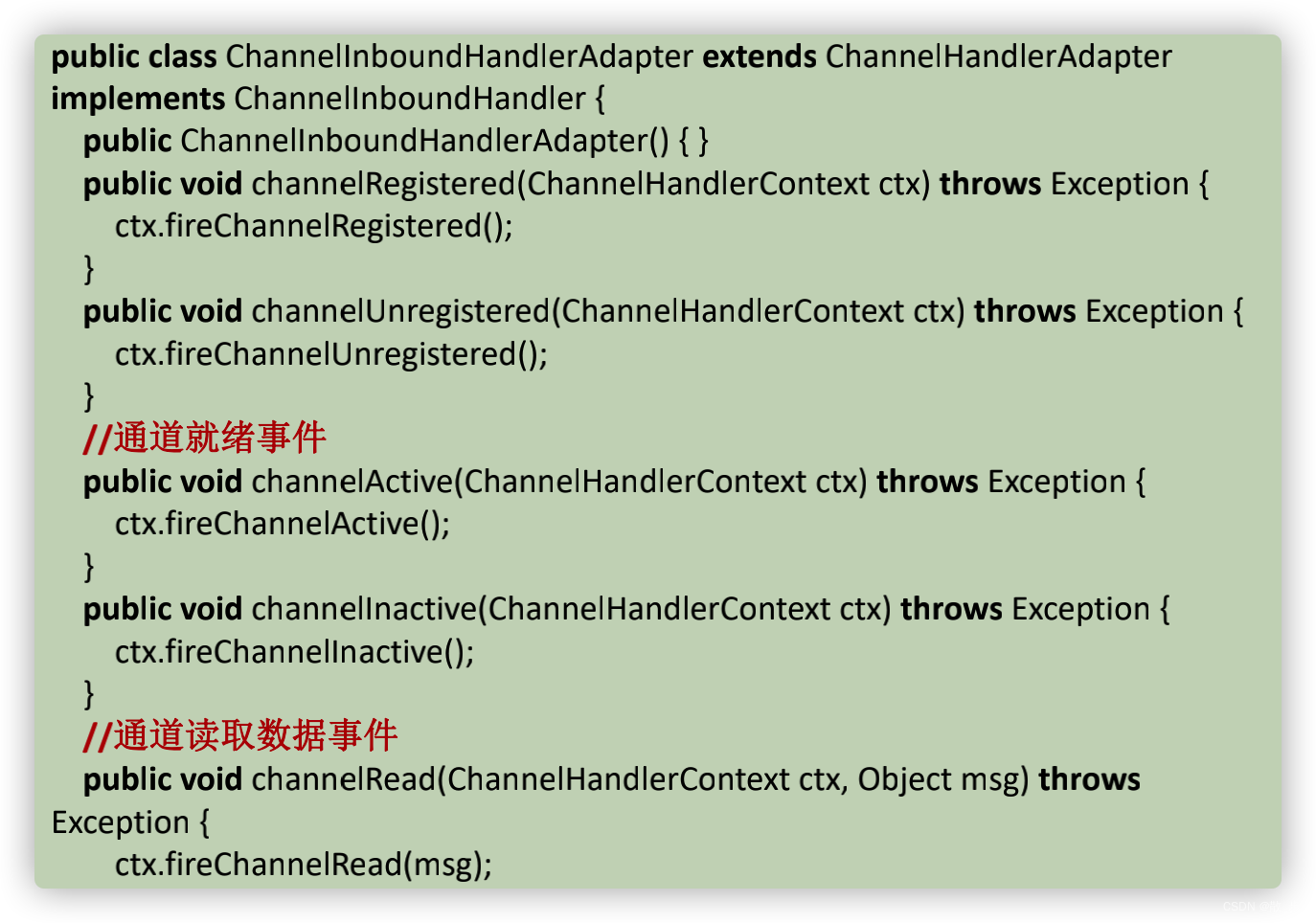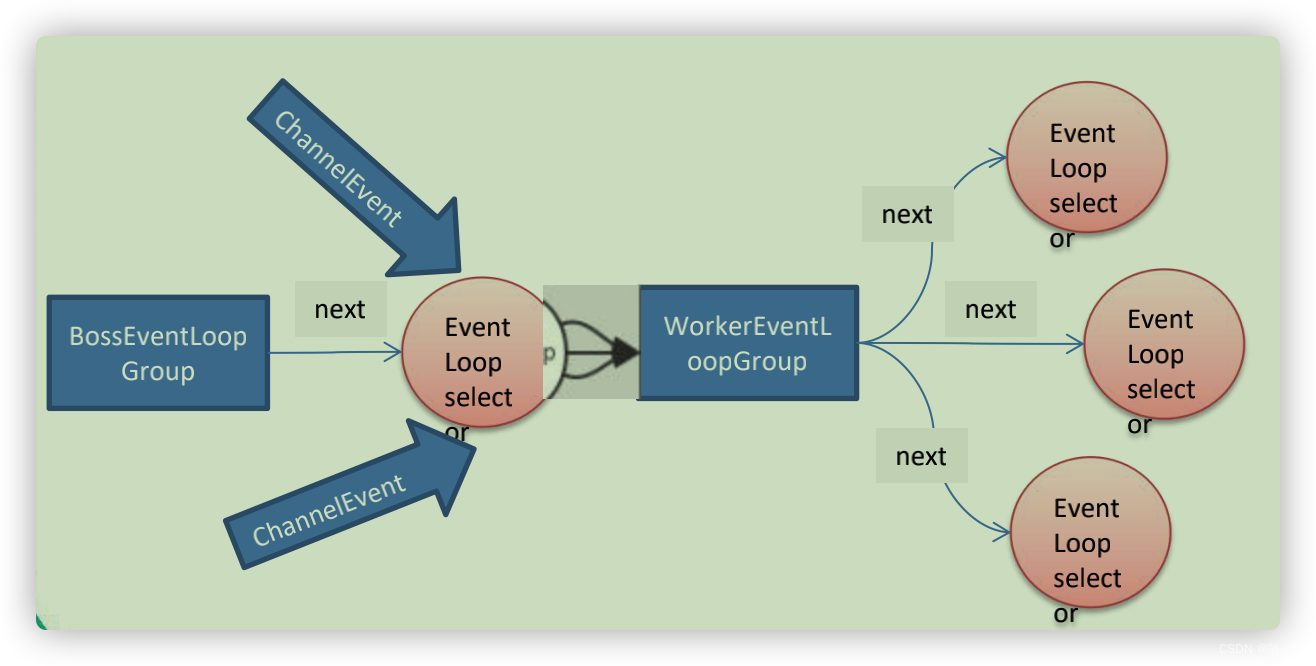Bootstrap、ServerBootstrap:
- Bootstrap 意思是引导,一个 Netty 应用通常由一个 Bootstrap 开始,
主要作用是配置 整个 Netty 程序,串联各个组件,Netty 中
Bootstrap 类是客户端程序的启动引导类,
ServerBootstrap 是服务端启动引导类 - 常见的方法有 :

Future、ChannelFuture:
- Netty 中所有的 IO 操作都是异步的,不能立刻得知消息是否被正确处理。
但是可以 过一会等它执行完成或者直接注册一个监听,具体的实现就是通过 Future 和 ChannelFutures,
他们可以注册一个监听,当操作执行成功或失败时监听会自动触发 注册的监听事件 - 常见的方法有
Channel channel(),返回当前正在进行 IO 操作的通道
ChannelFuture sync(),等待异步操作执行完毕
Channel:
- Netty 网络通信的组件,能够用于执行网络 I/O 操作。
- 通过Channel 可获得当前网络连接的通道的状态
- 通过Channel 可获得 网络连接的配置参数 (例如接收缓冲区大小)
- Channel 提供异步的网络 I/O 操作(如建立连接,读写,绑定端口),
异步调用意味着 任何 I/O 调用都将立即返回,并且不保证在调用结束时所请求的 I/O 操作已完成 - 调用立即返回一个 ChannelFuture 实例,通过注册监听器到 ChannelFuture 上,
可以 I/O 操作成功、失败或取消时回调通知调用方 - 支持关联 I/O 操作与对应的处理程序
- 不同协议、不同的阻塞类型的连接都有不同的 Channel 类型与之对应,常用的 Channel 类型

Selector:
- Netty 基于 Selector 对象实现 I/O 多路复用,通过 Selector 一个线程可以监听多个连 接的 Channel 事件。
- 当向一个 Selector 中注册 Channel 后,Selector 内部的机制就可以自动不断地查询 (Select)
这些注册的 Channel 是否有已就绪的 I/O 事件(例如可读,可写,网络连接 完成等),
这样程序就可以很简单地使用一个线程高效地管理多个 Channel
ChannelHandler 及其实现类:
- ChannelHandler 是一个接口,处理 I/O 事件或拦截 I/O 操作,并将其转发到其 ChannelPipeline(业务处理链)中的下一个处理程序。
- ChannelHandler 本身并没有提供很多方法,因为这个接口有许多的方法需要实现,方 便使用期间,可以继承它的子类
- ChannelHandler 及其实现类一览图(后)

- 我们经常需要自定义一 个 Handler 类去继承 ChannelInboundHandlerA dapter,
然后通过重写 相应方法实现业务逻辑, 我们接下来看看一般都 需要重写哪些方法

Pipeline 和 ChannelPipeline:
ChannelPipeline 是一个重点:
-
ChannelPipeline 是一个 Handler 的集合,它负责处理和拦截 inbound 或者 outbound 的事件和操作,
相当于一个贯穿 Netty 的链。
(也可以这样理解: ChannelPipeline 是 保存 ChannelHandler 的 List,用于处理或拦截 Channel 的入站 事件和出站操作 -
ChannelPipeline 实现了一种高级形式的拦截过滤器模式,使用户可以完全控制事 件的处理方式,以及 Channel 中各个的 ChannelHandler 如何相互交互
-
在 Netty 中每个 Channel 都有且仅有一个 ChannelPipeline 与之对应,它们的组成关系如下

一个 Channel 包含了一个 ChannelPipeline,而 ChannelPipeline 中又维护了一个由 ChannelHandlerContext 组成的双向链表,并且每个 ChannelHandlerContext 中又关联着一个 ChannelHandler
入站事件和出站事件在一个双向链表中,入站事件会从链表 head 往后传递到最后一个入站的 handler, 出站事件会从链表 tail 往前传递到最前一个出站的 handler,两种类型的 handler 互不干扰
4) 常用方法
• ChannelPipeline addFirst(ChannelHandler... handlers),把一个业务处理类(handler) 添加到链中的第一个位置
• ChannelPipeline addLast(ChannelHandler... handlers),把一个业务处理类(handler) 添加到链中的最后一个位置
ChannelHandlerContext:
- 保存 Channel 相关的所有上下文信息,同时关联一个 ChannelHandler 对象
- 即ChannelHandlerContext 中 包 含 一 个 具 体 的 事 件 处 理 器 ChannelHandler ,
同 时ChannelHandlerContext 中也绑定了对应的 pipeline 和 Channel 的信息,方便 对 ChannelHandler进行调用. - 常用方法:
• ChannelFuture close(),关闭通道
• ChannelOutboundInvoker flush(),刷新
• ChannelFuture writeAndFlush(Object msg)将 数 据 写 到 ChannelPipeline 中 当 前
• ChannelHandler 的下一个 ChannelHandler 开始处理(出站)
ChannelOption:
- Netty 在创建 Channel 实例后,一般都需要设置 ChannelOption 参数。
- ChannelOption 参数如下:

EventLoopGroup 和其实现类 NioEventLoopGroup:
-
EventLoopGroup 是一组 EventLoop 的抽象,Netty 为了更好的利用多核 CPU 资源,
一般会有多个 EventLoop 同时工作,每个 EventLoop 维护着一个 Selector 实例。 -
EventLoopGroup 提供 next 接口,可以从组里面按照一定规则获取其中一个 EventLoop来处理任务。
在 Netty 服务器端编程中,我们一般都需要提供两个 EventLoopGroup,例如:BossEventLoopGroup 和 WorkerEventLoopGroup。 -
通常一个服务端口即一个 ServerSocketChannel对应一个Selector 和一个EventLoop 线程。
BossEventLoop 负责接收客户端的连接并将 SocketChannel 交给 WorkerEventLoopGroup 来进行 IO 处理,如下图所示

• BossEventLoopGroup 通常是一个单线 程的 EventLoop,EventLoop 维护着一 个注册了ServerSocketChannel 的 Selector 实例BossEventLoop 不断轮询 Selector 将连接事件分离出来
• 通常是 OP_ACCEPT 事件,然后将接收 到的 SocketChannel 交给 WorkerEventLoopGroup
WorkerEventLoopGroup 会由 next 选择 其中一个 EventLoop来将这个 SocketChannel
• 注册到其维护的 Selector 并对其后续的 IO 事件进行处 理
- 常用方法:
• public NioEventLoopGroup(),构造方法
• public Future<?> shutdownGracefully(),断开连接,关闭线程
Unpooled 类:
- Netty 提供一个专门用来操作缓冲区(即Netty的数据容器)的工具类
- 常用方法如下所示
//通过给定的数据和字符编码返回一个 ByteBuf 对象**(类似于 NIO 中的 ByteBuffer 但有区别)** public static ByteBuf copiedBuffer(CharSequence string, Charset charset)
import io.netty.buffer.ByteBuf;
import io.netty.buffer.Unpooled;
public class NettyByteBuf01 {
public static void main(String[] args) {
//创建一个ByteBuf
//说明
//1. 创建 对象,该对象包含一个数组arr , 是一个byte[10]
//2. 在netty 的buffer中,不需要使用flip 进行反转
// 底层维护了 readerindex 和 writerIndex
//3. 通过 readerindex 和 writerIndex 和 capacity, 将buffer分成三个区域
// 0---readerindex 已经读取的区域
// readerindex---writerIndex , 可读的区域
// writerIndex -- capacity, 可写的区域
ByteBuf buffer = Unpooled.buffer(10);
for(int i = 0; i < 10; i++) {
buffer.writeByte(i);
}
System.out.println("capacity=" + buffer.capacity());//10
//输出
// for(int i = 0; i<buffer.capacity(); i++) {
// System.out.println(buffer.getByte(i));
// }
for(int i = 0; i < buffer.capacity(); i++) {
System.out.println(buffer.readByte());
}
System.out.println("执行完毕");
}
}
import io.netty.buffer.ByteBuf;
import io.netty.buffer.Unpooled;
import java.nio.charset.Charset;
public class NettyByteBuf02 {
public static void main(String[] args) {
//创建ByteBuf
ByteBuf byteBuf = Unpooled.copiedBuffer("hello,world!", Charset.forName("utf-8"));
//使用相关的方法
if(byteBuf.hasArray()) { // true
byte[] content = byteBuf.array();
//将 content 转成字符串
System.out.println(new String(content, Charset.forName("utf-8")));
System.out.println("byteBuf=" + byteBuf);
System.out.println(byteBuf.arrayOffset()); // 0
System.out.println(byteBuf.readerIndex()); // 0
System.out.println(byteBuf.writerIndex()); // 12
System.out.println(byteBuf.capacity()); // 36
//System.out.println(byteBuf.readByte()); //
System.out.println(byteBuf.getByte(0)); // 104
int len = byteBuf.readableBytes(); //可读的字节数 12
System.out.println("len=" + len);
//使用for取出各个字节
for(int i = 0; i < len; i++) {
System.out.println((char) byteBuf.getByte(i));
}
//按照某个范围读取
System.out.println(byteBuf.getCharSequence(0, 4, Charset.forName("utf-8")));
System.out.println(byteBuf.getCharSequence(4, 6, Charset.forName("utf-8")));
}
}
}
Netty 网络编程应用实例-群聊系统:
import io.netty.bootstrap.Bootstrap;
import io.netty.channel.*;
import io.netty.channel.nio.NioEventLoopGroup;
import io.netty.channel.socket.SocketChannel;
import io.netty.channel.socket.nio.NioSocketChannel;
import io.netty.handler.codec.string.StringDecoder;
import io.netty.handler.codec.string.StringEncoder;
import java.util.Scanner;
public class GroupChatClient {
private final String host;
private final int port;
public GroupChatClient(String host, int port) {
this.host = host;
this.port = port;
}
public void run() throws InterruptedException {
EventLoopGroup group = new NioEventLoopGroup();
try{
Bootstrap bootstrap = new Bootstrap();
bootstrap.group(group)
.channel(NioSocketChannel.class)
.handler(new ChannelInitializer<SocketChannel>() {
@Override
protected void initChannel(SocketChannel ch) throws Exception {
ChannelPipeline pipeline = ch.pipeline();
//加入了相关的handler
pipeline.addLast("decoder", new StringDecoder());
pipeline.addLast("encoder", new StringEncoder());
// 加入自定义的handler
pipeline.addLast("GroupChatClientHandler", new GroupChatClientHandler());
}
});
ChannelFuture channelFuture = bootstrap.connect(host, port).sync();
Channel channel = channelFuture.channel();
System.out.println("--------"+channel.localAddress()+"--------");
// 创建一个扫描器
Scanner scanner = new Scanner(System.in);
while (scanner.hasNextLine()){
String msg = scanner.nextLine();
// 通过channel发送到服务器端
channel.writeAndFlush(msg+"\r\n");
}
}catch (Exception e){
e.printStackTrace();
}finally {
group.shutdownGracefully();
}
}
public static void main(String[] args) throws InterruptedException {
new GroupChatClient("127.0.0.1",7000).run();
}
}
import io.netty.channel.ChannelHandlerContext;
import io.netty.channel.SimpleChannelInboundHandler;
public class GroupChatClientHandler extends SimpleChannelInboundHandler<String> {
@Override
protected void channelRead0(ChannelHandlerContext ctx, String msg) throws Exception {
System.out.println(msg.trim());
}
}
import io.netty.bootstrap.ServerBootstrap;
import io.netty.channel.*;
import io.netty.channel.nio.NioEventLoopGroup;
import io.netty.channel.socket.SocketChannel;
import io.netty.channel.socket.nio.NioServerSocketChannel;
import io.netty.handler.codec.string.StringDecoder;
import io.netty.handler.codec.string.StringEncoder;
public class GroupChatServer {
private int port;
public GroupChatServer(int port) {
this.port = port;
}
// 编写run方法,处理客户端的请求
public void run() throws InterruptedException {
// 创建两个线程组
EventLoopGroup bossGroup = new NioEventLoopGroup(1);
EventLoopGroup workGroup = new NioEventLoopGroup();
try{
ServerBootstrap serverBootstrap = new ServerBootstrap();
serverBootstrap.group(bossGroup,workGroup)
.channel(NioServerSocketChannel.class)
.option(ChannelOption.SO_BACKLOG,128)
.childOption(ChannelOption.SO_KEEPALIVE,true)
.childHandler(new ChannelInitializer<SocketChannel>() {
@Override
protected void initChannel(SocketChannel ch) throws Exception {
// 获取到ChannelPipeline
ChannelPipeline pipeline = ch.pipeline();
// 向ChannelPipeline 中加入解码器
pipeline.addLast("decoder", new StringDecoder());
// 向ChannelPipeline 中加入编码器
pipeline.addLast("encoder", new StringEncoder());
//加入自己的业务处理handler
pipeline.addLast(new GroupChatServerHandler());
}
});
System.out.println("netty 服务器启动了");
ChannelFuture channelFuture = serverBootstrap.bind(port).sync();
//监听关闭
channelFuture.channel().closeFuture().sync();
}catch (Exception e){
e.printStackTrace();
}finally {
bossGroup.shutdownGracefully();
workGroup.shutdownGracefully();
}
}
public static void main(String[] args) {
try {
new GroupChatServer(7000).run();
} catch (InterruptedException e) {
e.printStackTrace();
}
}
}
import io.netty.channel.Channel;
import io.netty.channel.ChannelHandlerContext;
import io.netty.channel.SimpleChannelInboundHandler;
import io.netty.channel.group.ChannelGroup;
import io.netty.channel.group.DefaultChannelGroup;
import io.netty.util.concurrent.GlobalEventExecutor;
import java.text.SimpleDateFormat;
public class GroupChatServerHandler extends SimpleChannelInboundHandler<String> {
//定义一个channel组 管理所有的channel
//GlobalEventExecutor.INSTANCE 全局的时间执行器 是一个单例
private static ChannelGroup channelGroup = new DefaultChannelGroup(GlobalEventExecutor.INSTANCE);
SimpleDateFormat sdf = new SimpleDateFormat("yyyy-MM-dd HH:mm:ss");
//handlerAdded 标识连接被建立 一旦连接,第一个被执行
// 将当前的 channel 加入到ChannelGroup
@Override
public void handlerAdded(ChannelHandlerContext ctx) throws Exception {
Channel channel = ctx.channel();
// 将该客户加入聊天的信息推送给其他在线的客户端
// 该方法会将channelGroup 中所有的channel 遍历 并发送消息
// 我们不需要自己遍历
channelGroup.writeAndFlush("[客户端:]" + channel.remoteAddress() + " 加入聊天\n");
channelGroup.add(channel);
}
//表示 channel 断开连接 将立刻客户信息推送给当前在线客户
@Override
public void handlerRemoved(ChannelHandlerContext ctx) throws Exception {
Channel channel = ctx.channel();
channelGroup.writeAndFlush("[客户端:]" + channel.remoteAddress() + " 离开了\n");
System.out.println("channelGroup size 数量:"+ channelGroup.size());
}
//表示 channel 处于活动状态 提示xxx 上线
@Override
public void channelActive(ChannelHandlerContext ctx) throws Exception {
System.out.println(ctx.channel().remoteAddress()+ " 上线了");
}
//表示 channel 处于非活动状态 提示xxx 下线了
@Override
public void channelInactive(ChannelHandlerContext ctx) throws Exception {
System.out.println(ctx.channel().remoteAddress()+ " 下线了");
}
@Override
public void exceptionCaught(ChannelHandlerContext ctx, Throwable cause) throws Exception {
// 出现异常,关闭通道
ctx.close();
}
@Override
protected void channelRead0(ChannelHandlerContext ctx, String msg) throws Exception {
// 获取channel
Channel channel = ctx.channel();
//我们遍历channelGroup ,根据不同的情况,回送不同的消息
channelGroup.forEach(e -> {
if(e != channel){
// 不是当前的channel就转发
e.writeAndFlush("[客户]" + channel.remoteAddress() + " 发送了消息" + msg + "\n");
}else{
// 如果是当前channel
e.writeAndFlush("自己发送了消息" + msg + "\n");
}
});
}
}





















 5602
5602











 被折叠的 条评论
为什么被折叠?
被折叠的 条评论
为什么被折叠?








